Dell G7 15 (7588) review: A six-core gaming laptop that won’t break the bank - delongdeent1951

Adam Patrick Murray/IDG
At a Glance
Skilful's Rating
Pros
- Solid GTX 1060 Max-Q gaming performance with border rates north of 60
- Relatively slim down design
- Blazingly fastened six-core i7 C.P.U.
Cons
- Dim showing
- Runs hot when playing graphically intense games
Our Verdict
One-armed with a screamingly fast positional representation system-core CPU and a within reason robust graphics lineup, the Dell G7 15 packs an impressive amount of processing and gaming tycoo into a shell that's little than an in slurred.
Top-grade Prices Nowadays

$
The Dingle G7 15 is a mid-size gaming laptop with midway-of-the-road GTX 1060 Max-Q artwork, middling battery life, and—you guessed it—a mid-lay out price tag of $1,200. But this system boasts a stellar lineament that sets IT separate from the crowd: a cardinal-effect, benchmark-crushing Core i7 processor that'll thrill content creators. So, the G7 15's overall performance is only a step or cardinal in arrears that of our current 15-edge in play laptop, the thinner and light MSI GS65 Stealth Vapourous 8RE, spell costing nigh $600 less. Among our quibbles: a shadowy cover and an occasionally too-hot chassis.
This brush up is set out of our best gaming laptops roundup. Cristal there for details well-nig competing products and how we proven them.
Price & specifications
We tested the $1,199 model of the Dell G7 15 (Manikin 7588), which comes with Intel's six-pith Core i7-8750H central processor, 16GB of DDR4 RAM, a 128GB congealed-state boot ride and a traditional 1TB hard drive for data. With a total of 12 processing threads (thanks to Intel's Hyper Threading technology), the G7 15 packs in an impressive amount of multitasking office, as we'll examine once we get to our benchmarks.
On the optic side, the G7 15 boasts a 15.6-inch opposed-glare full-HD (1920×1080) IPS-applied science display, positive an Nvidia GeForce GTX 1060 processor with 6GB of GDDR5 RAM and Max-Q design (which puts a palpebra on performance to slice major power consumption and heat outturn). Nonmoving in the middle of Nvidia's GeForce GTX 10 Series picture card game, the GTX 1060 with Scoop-Q dependably delivers 60 FPS and prepared for most current top-tier games.
You can knock about $120 cancelled the price tag of our G7 15 revaluation unit by snapping up a model with 8GB of Drive rather than 16GB, while the priciest version swaps in a beefier, overclockable six-core i9-8950HK processor. There's also a G7 15 laptop computer with a 4K display (addition the standard i7-8750H CPU) for $1,499. Incidentally, every laptop in Dell's G7 15 line comes with the same GTX 1060 art card with Georgia home boy-Q design.
Design
Measurement 15.32 x 10.82 x 0.98 inches and weighing a substantial but not prohibitive 6 pounds, 4 ounces (or 7 pounds, 2 ounces with the chunky 180-watt AC adapter), the Dell G7 15's heft paradoxically makes it feel thinner than you'd expect. That aforesaid, the G7 successful for a tight squeeze in my 15-inch laptop bag.
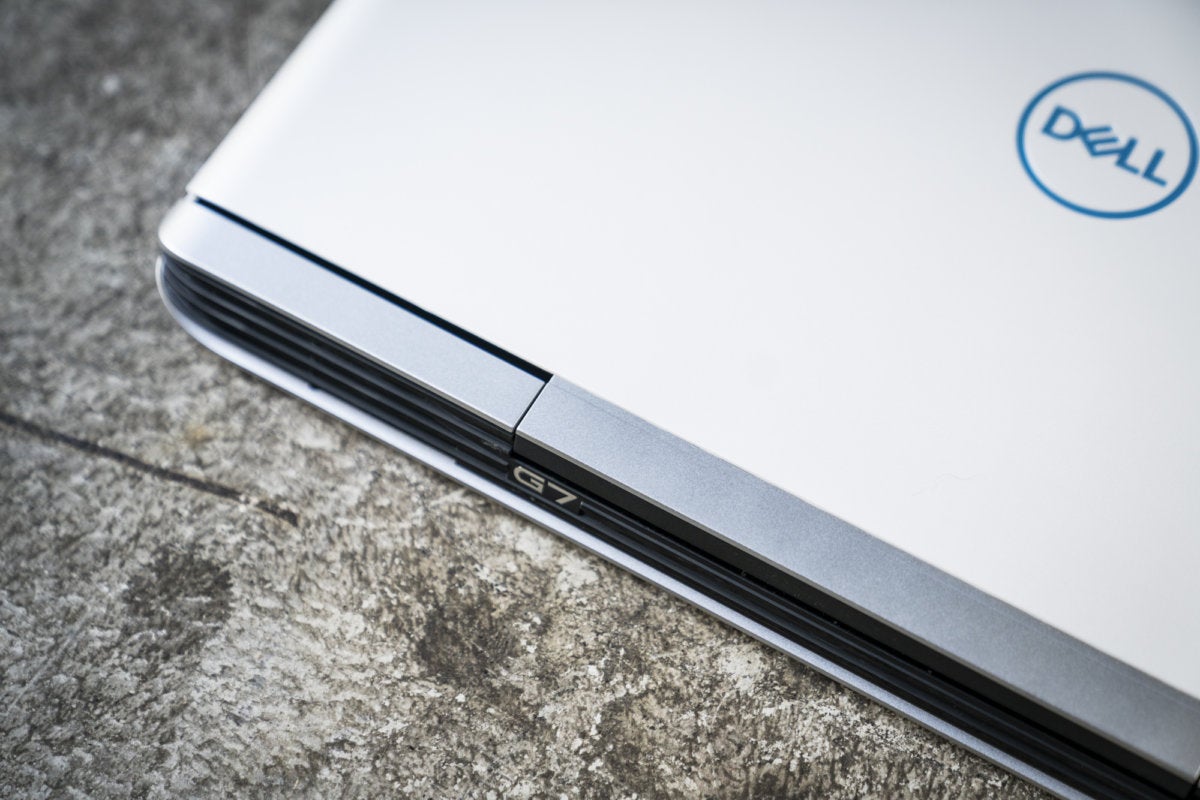 Adam Patrick Murray/IDG
Adam Patrick Murray/IDG The twin cooling vents in back of the Dell G7 15 look understated, yet awing.
Available in "Licorice Black" and "Alpine White" flavors (we tested the Alpine White variety), the Dell G7 15 boasts a sporty still understated look. The plain, reasonably inconspicuous lid is offset by a slanted front man inch that boasts a nifty black grille, while the twinned cooling vents in back look elegant and powerful.
Maiden the lid reveals a relatively thick bezel (about three-quarters of an inch along the top and sides, plus an inch at the backside) around the 15.6-edge display, plus a fluent, sooty palm rest that's slightly indented around the keyboard.
Display
The Dingle G7 15's non-touch, 1920×1080 presentation boasts solid viewing angles. The display dims a little protrusive around 45 degrees from the sides, top and bottom, with no signs of inverse colors as you might see on a cheap laptop screen. That's pretty much par for the course when it comes to an IPS reveal look-alike the G7's.
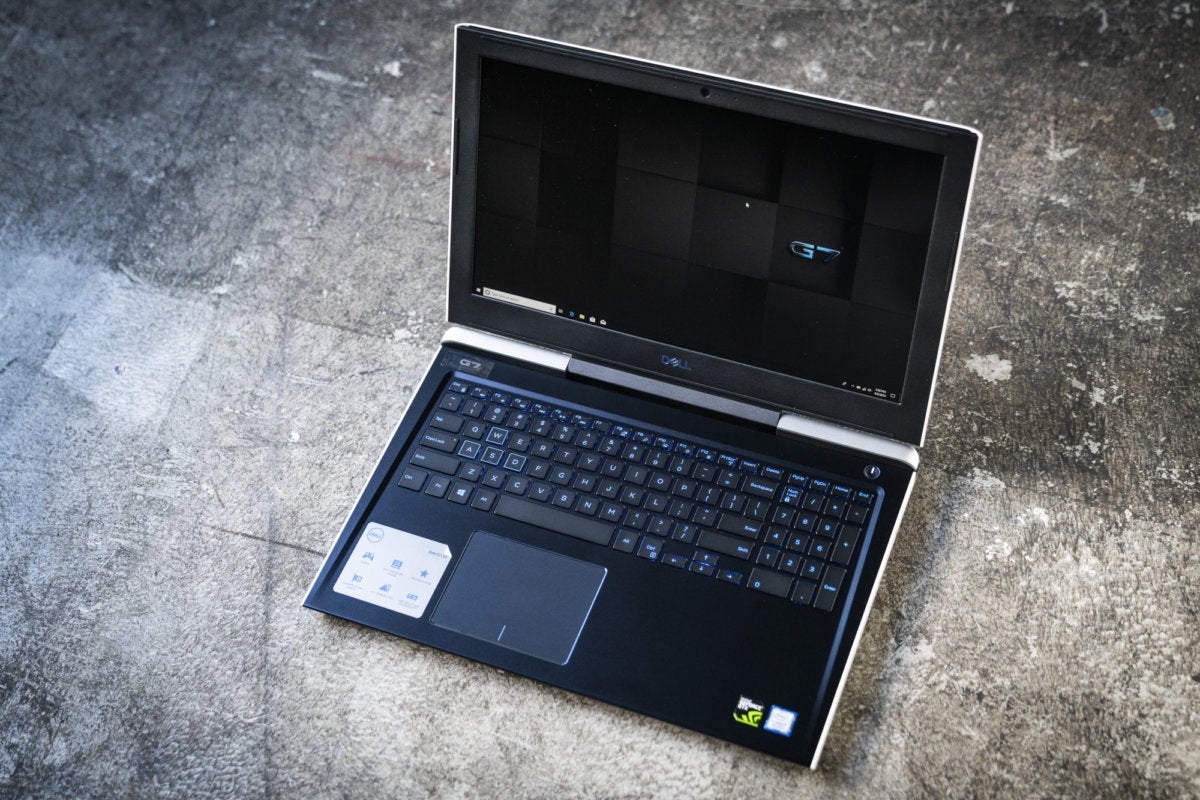 Adam Patrick Murray/IDG
Adam Patrick Murray/IDG The Dell G7 15's 15.6-inch IPS display delivers good viewing angles, but we indirect request it was brighter.
While the Dell G7 15's viewing angles look good, the same rear't be said for brightness. Mensuration just 234 nits (or candelas), the G7's screen brightness falls somewhat fleeting of the 250-nit minimum we prefer. In an office setting or a den, the G7 15's stupid screen out isn't a Brobdingnagian problem, but I had trouble making outgoing one of the darker levels in Diablo 3 while I was gaming near a bright window.
Keyboard, trackpad, speakers, webcam
The Dell G7 15's chiclet-style keyboard is standard mid-range laptop fare, with smooth, flat keys, decent travel and a snappish perception bump in the middle of each keystroke. The outlined WASD keys did their individual jobs during gambling, neither impressing me nor acquiring in my way. A 10-key numeric keypad sits on the right, while standard function-enabled hotkeys such as screen lock away, search, brightness, media playback, and airplane mode are likewise on tap. The G7 eschews fancy LED backlighting schemes for a basic deuce-stone's throw low-spirited glow.
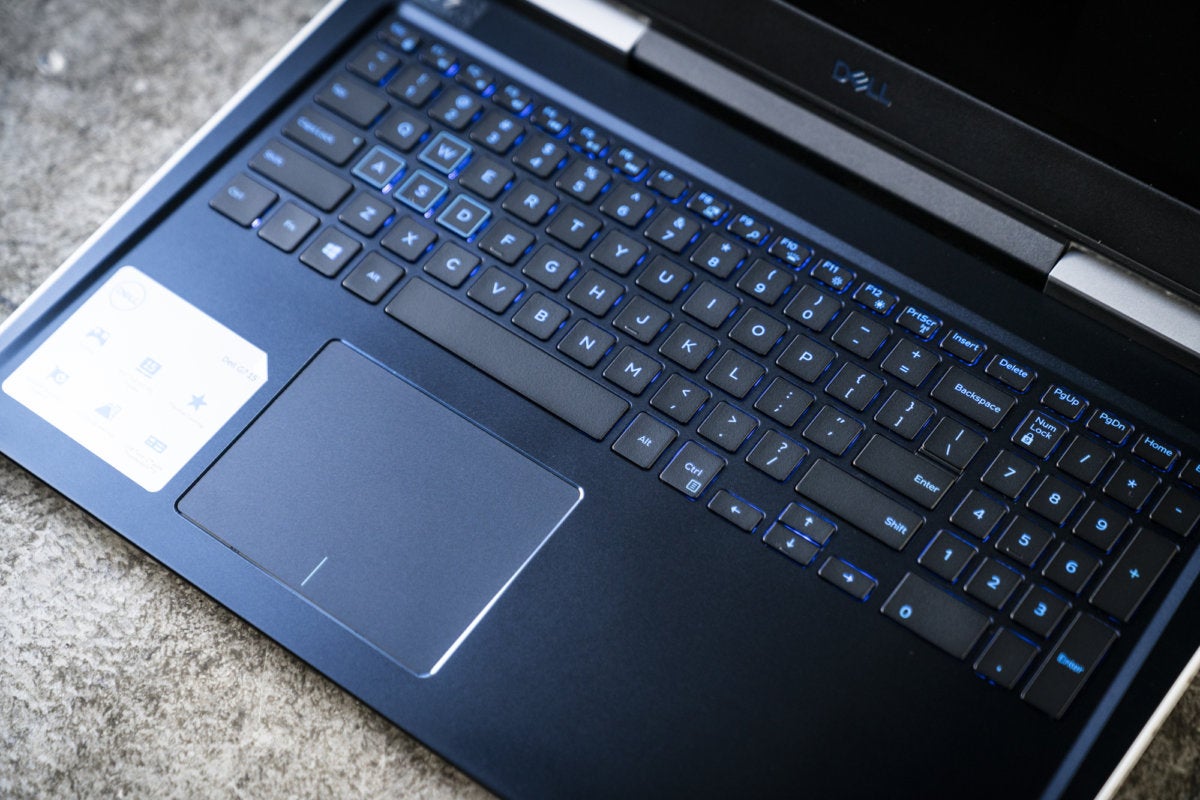 Adam Patrick Murray/IDG
Adam Patrick Murray/IDG Nothing about the Dell G7 15's backlit keyboard screams "play" except for the outlined WASD keys.
Stationed a bit left of center to stay fresh it directly down the stairs the spacebar, the Dingle G7 15's mid-sized trackpad responded to my swipes with a minimum of jitter, while also avoiding mistaken inputs from my palms. Clicking feels a little stiff, per usual, merely that shouldn't matter much to gamers, who will probably be using mice virtually of the time.
While they're no substitute for a good duo of headphones, the Dingle G7 15's go past-discharge speakers are a slight trimmed above the tinny, deep-deprived speakers you'll find in most laptops. Music sounded relatively detailed without collapsing into mush. While you shouldn't expect any banging beats, leastwise you'll hear a soupco of bass. You can as wel crank the G7's speakers to an imposingly top volume—a swell thing, as it turns out, because the cooling fans have a disposition to spin themselves busy a roar during graphically intense games. (More on the G7 15's heat issues in a bit.)
Video captured by the Dell G7 15's webcam (its lens sits in the top bezel of the display) looks typically granular and blotchy, albeit with decent contrast and color. While the G7's webcam is fine for Skype, gamers looking to make waves on Jerk would do better with a ordained lens.
Ports
The Dell G7 15 comes with a solid excerpt of ports, starting on the left with an ethernet port, USB 3.1 Gen. 2 Typecast-A, and an SD remembering card reader. Also on the left English: a Noble lock chamber security port and a barrel-shaped power-in porthole.
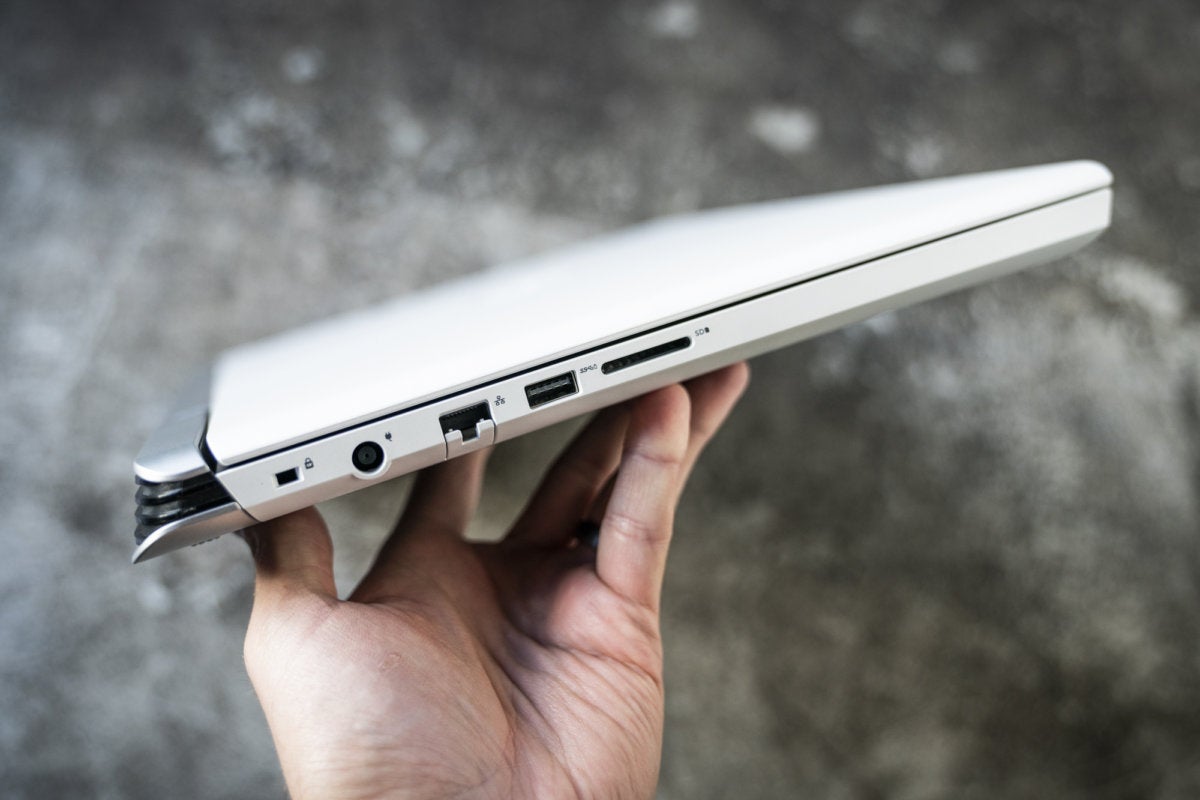 Adam Patrick Murray/IDG
Adam Patrick Murray/IDG The left-side ports on the Dell G7 15 let in ethernet, a USB 3.0 porthole, and an SD memory card reader.
On the right side of the G7 15, you'll find HDMI 2.0, a Thunderbolt 3 port, cardinal more USB 3.1 Type-A ports (with PowerShare), and a combo audio mariner.
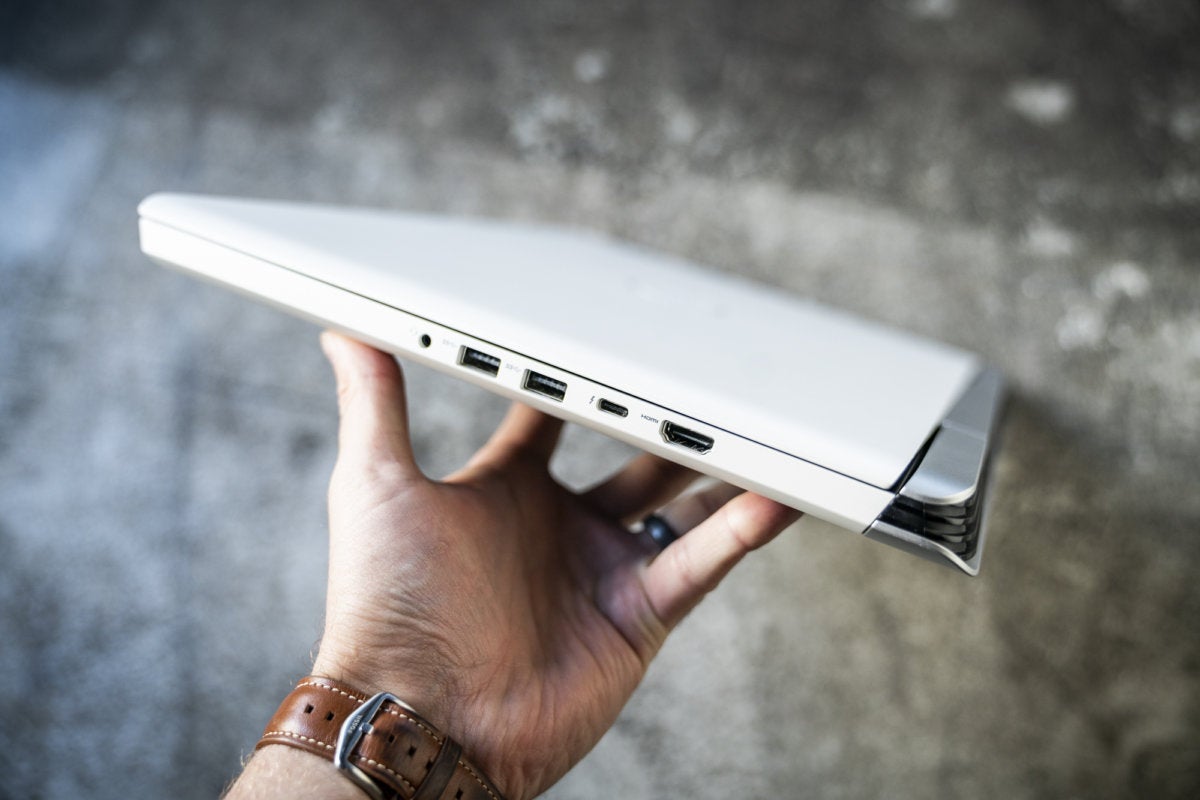 Adam Patrick Sir James Murray/IDG
Adam Patrick Sir James Murray/IDG A Thunderclap 3 port sits connected the right side of meat of the Dell G7 15, along with HDMI 2.0, a brace of USB 3.1 Gen 1 Type-A ports, and an audio jack.
Common performance
While the Dell G7 15's middle-of-the-road GTX 1060 Max-Q video card delivers expectedly mid-range artwork performance, its six-core CPU—among the first we've seen in a comparatively vapourous play laptop, although we can expect many much in the near future—cranked out some genuinely impressive numbers, perfect for gamers who want to take a break from shooting things to create other things.
HandBrake
In our prime benchmark, we use the free HandBrake utility to encode a 40GB telecasting file into an Android lozenge-compatible format. It's a CPU-intensive job that can buoy take an hour or more to complete, and it tends to reel up cooling fans in the process. Piece a nice HandBrake score doesn't of necessity equalize to stellar gaming visuals (we'll get to play performance in a moment), it does bode well for YouTube content creators, Flip broadcasters, OR anyone else who plans on multitasking while gambling.
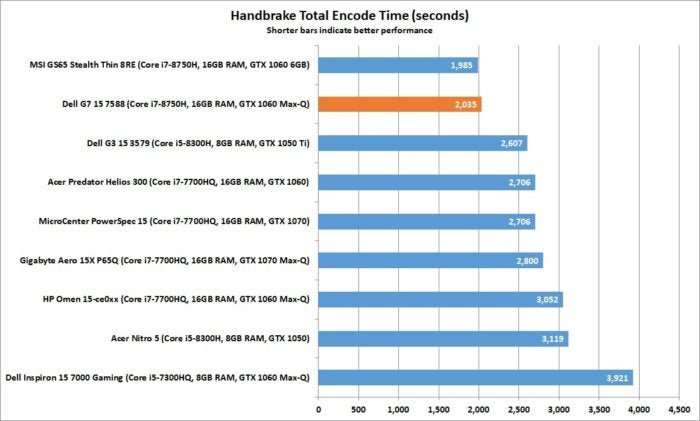 Melissa Riofrio/IDG
Melissa Riofrio/IDG The Dingle G7 15 chewed through our Handbrake benchmark thanks to its speedy hex-core i7 CPU.
Processors with the most cores by and large do better with HandBrake, and yes, the Dingle G7 15 and its six-center Center i7-8750H CPU absolutely crushes it. So, with its Handbrake score of 2,035 seconds, surgery just a bit over half an hour, the G7 15 trails solitary the mistakable half-dozen-core MSI GS65 Stealth Thin 8RE, a razor-thin gaming laptop that costs $600 more than.
The next-fastest competitor in our comparing, the Dingle G3 15 with a quadrangle-core i5-8300H processor, took an additional 10 transactions to complete the Handbrake test, followed by a series of Core i7-7700HQ-power-driven laptops, demonstrating the remainder those extra cores build when it comes to CPU-intensive tasks.
Cinebench
Future up, our Cinebench test involves another stressful computation task: rendering a 3D image in real-sentence. Because Cinebench takes only a some minutes to perform, it gives us a good idea of how a given laptop handles short bursts of bad activity. We lam Cinebench in some multi-threaded and single-yarn modes, handy for illustrating the carrying out benefits of extra cores and threads.
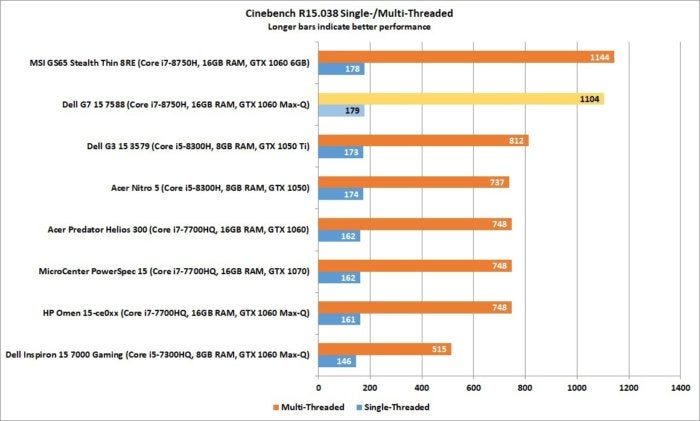 Melissa Riofrio/IDG
Melissa Riofrio/IDG The Dingle G7 15's Cinebench hit shows what a difference six cores of processing power take a leak compared to four.
Unsurprisingly, the 12-threaded Dell G7 15 shines when it comes to Cinebench's multi-threaded test, unrivalled once more notching a score entirely slenderly buns that of the MSI GS65 Stealing Spare 8RE, while handily dusting its quad-core competition. We're also pleased aside the Dingle's chart-topping unwedded-meander result.
(Note: Results for the Gigabyte Aero 15X, a system seen in past charts in this story, were not available for this test.)
Gaming carrying out
We'll start our gaming tests with FireStrike Extreme, a synthetic benchmark that doesn't straightaway transform to gaming performance but withal gives us a good baseline for comparisons.
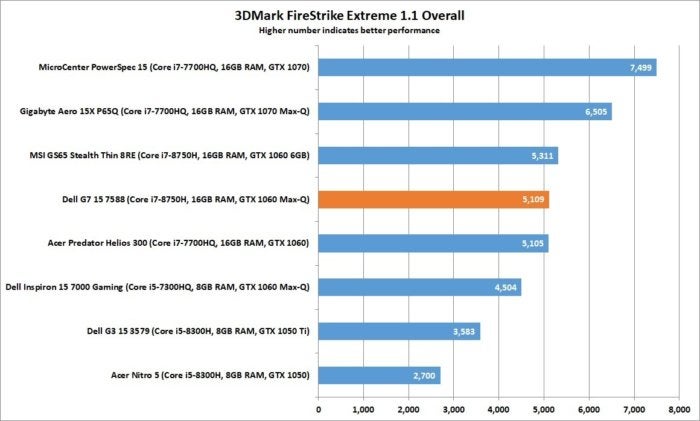 Melissa Riofrio/IDG
Melissa Riofrio/IDG The Dell G7 15's middle-range GTX 1060 video card unsurprisingly lands it midmost of bundle when IT comes to FireStrike Extreme.
The Dingle G7 15's FireStrike Intense hit lands in the midst of the pack, which makes perfect sense given its GTX 1060 with Max-Q. The tipto two finishers in our graph, the MicroCenter PowerSpec 15 and the Gigabyte Aero 15X P65Q, boast more efficacious GTX 1070 cards, while most of the laptops that trail the Dell have GTX 1050 GPUs. The MSI GS65 Stealth Bony 8RE with a similar GTX 1060 card (albeit using a full-fat form, compared to the G7's power-optimized Georgia home boy-Q purpose) manages a slenderly better FireStrike Extreme point score than the G7 15, but as we'll see in a bit, it doesn't make much difference when it comes to real-existence gaming.
(Note: Results for the HP Omen 15-ce0xx, a scheme seen in other charts in this story, were non available for this test.)
Oral presentation of substantial-world play, permit's begin with 2013's Tomb Raider reboot, a game that leans a little more on C.P.U. power than more Recent titles.
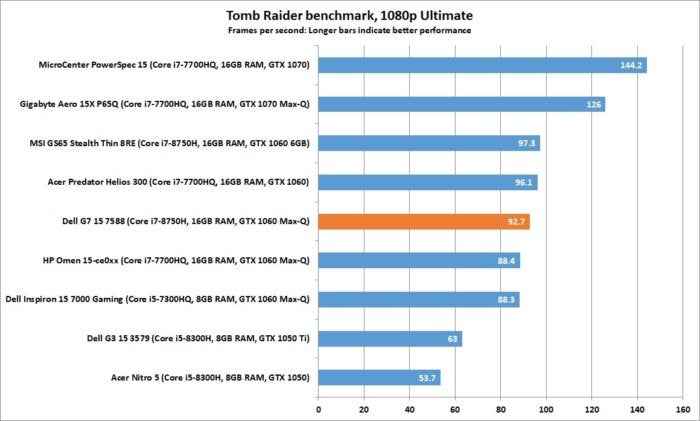 Melissa Riofrio/IDG
Melissa Riofrio/IDG Without a GTX 1070 or better picture card, the Dell G7 15's Tomb Raider framework rates are stuck in the 90 roll.
We'd expect a laptop with a GTX 1060 video carte to squeeze out a Tomb Raider frame rate somewhere in the 90s, and that's pretty much what we got from the Dell G7 15. While the GTX 1060-powered MSI GS65 Stealth Thin 8RE enjoys (A we just proverb) a weak FireStrike Extreme advantage over the G7, it gets only a modest Tomb Looter frame up value chance over the Dingle (97.2 Federal Protective Service versus 92.7 fps). To see a more significant boost in Tomb Raider frame rates, you'd pauperization to cough up more for a laptop with GTX 1070 or better graphics, such as the MicroCenter PowerSpec 15.
We see more of the assonant with Middle-earth: Shadow of Mordor. Totally the GTX 1060 Scoop-Q-powered laptops in our chart—including the Dell G7 15—bunched up around in the 80-90 fps crop, piece a pair of laptops with full-fat GTX 1060 nontextual matter sawing machine a demure bump to 90-100 fps.
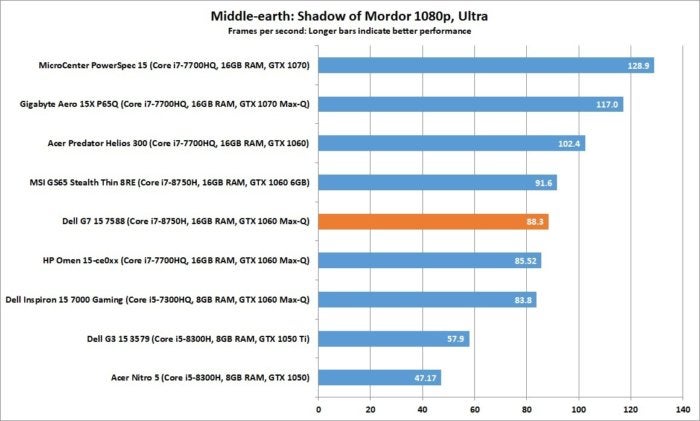 Melissa Riofrio/IDG
Melissa Riofrio/IDG As with Tomb Raider, the GTX 1060-high-powered Dell G7 15's Middle-earth: Shadow of Mordor skeletal frame rates are (appropriately) middle-of-the-roadworthy.
For Shadow of Mordor frame rates above 120, you'll generally need to step up to a organization with GTX 1070 operating theatre better graphics.
In conclusion, we pink-slipped up Rise of the Grave Raider, a graphically intense title that demands at to the lowest degree GTX 1060 nontextual matter to accomplish a smooth 60 Federal Protective Service.
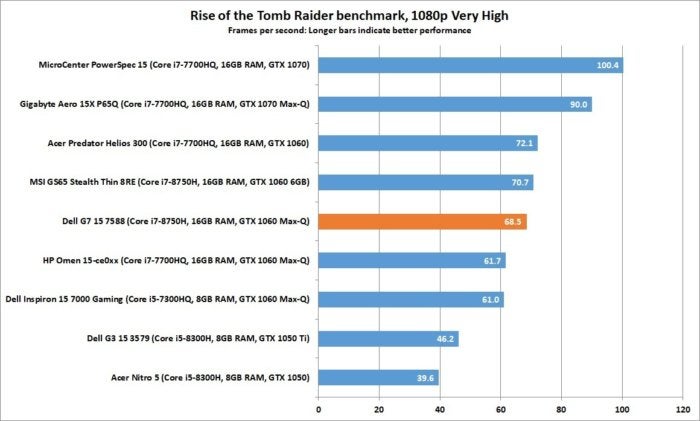 Melissa Riofrio/IDG
Melissa Riofrio/IDG The Dell G7 15 and its GTX 1060 Max-Q picture scorecard can nut unstylish Rise of the Tomb Raider above 60 FPS, but only just.
The Dell G7 15 and its GTX 1060 Max-Q graphics go to sleep a solid 68.5 Federal Protective Service, spell the similarly equipped Acer Piranha Helios 300 and MSI GS65 Stealth Thin 8RE seat in the same ballpark with 72.1 and 70.7 fps, respectively. Play laptops with GTX 1070 or advisable artwork (like the MicroCenter PowerSpec 15) can wring more than 100 Federal Protective Service from Rise of the Grave Raider, patc sub-$1,000 GTX 1050-power-driven laptops like Dell's own G3 15 typically settle for between 30-45 fps.
Gaming laptops fanny get hot. Keep reading for our experience with the G7 15.
When a hot biz gets too hot
Now, a word nigh estrus. While playing Rise of the Tomb Raider, I detected that the Dell G7 15's cooling fans were roaring and the chassis got uncomfortably hot, particularly near the whirligig of the keyboard and a tad to the right. Indeed, the 7, 8, and 9 keys got so hot that they felt equal they were painful my fingertips.
Later on nearly on hour of Rise of the Tomb Raider, I check the G7's CPU software system temperature and got a reading of 98 degrees Celsius (208 degrees Fahrenheit), hot decent to boil water and a mere two degrees diffident of the Effect i7-8750H's maximum operating temperature. The Processor also attached thermal throttling repeatedly in an deed to cool things down.
So, does the Dell G7 15 feature a cooling problem? Not inevitably. Yes, the G7 runs hot, but its CPU software program temperatures do remain within Intel's specifications. Also, Nvidia's Max-Q spec is well-meant to chock up as much GPU power as IT can into the smallest possible space, meaning temperatures are bound to rise. I should besides point out that the G7 15 ran moderately cooler while playing less graphically exacting titles like Diablo 3 and World of Warcraft (a game that maps the 7, 8, and 9 keys to diverse spells and abilities).
Still, the G7's leaning to run nigh is an piteous fact of life for play laptops as thin and light (relatively speaking, anyhow) as this one.
Barrage fire life
You can't expect all-day battery life from a gaming laptop computer, but the Dell G7 15 and its 55-watt-hour shelling do a reasonably good job of staying alive without help from the bulky AC adapter.
We test barrage life connected a laptop by looping a 4K video using the stock Windows 10 Movies & TV app, with screen brightness set at about 250 nits (which, in the G7 15's case, meant cranking the brightness whol the way up) and volume dialed capable 50 percent, headphones plugged in.
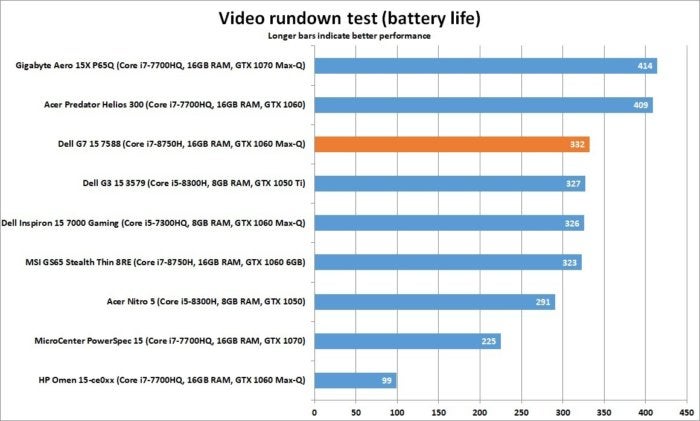 Genus Melissa Riofrio/IDG
Genus Melissa Riofrio/IDG The Dell G7 15's battery life is comparatively solidness given its 55 watt-hour battery.
The Dell G7 15's result of 332 minutes (about 5.5 hours) isn't too dishonorable for a play laptop, landing in the middle of the pack with roughly the same battery life American Samoa the cheaper Dell G3 15, the older Dell Inspiron 15 7000 Gaming, and the lithesome MSI GS65 Stealth Thin 8RE. Notably, the 5.5-pound Genus Acer Piranha Helios 300 squeezes to a higher degree an hour of additional lifespan out of its slightly smaller 48 Watt-hour barrage fire, and that's despite its full-fleshy GTX 1060 video card. The laptop computer in our roundup with the best battery biography, the Gigabyte Aero 15X P65Q (which includes a power-hungry 4K display), boasts a massive 94 watt-hour shelling.
Last
Armed with a screamingly fast six-meat C.P.U. and a fairly potent nontextual matter card, the $1,200 Dingle G7 15 packs an impressive amount of processing and gaming power into a shell that's to a lesser degree an edge thick. Gamers looking for the highest frame rates possible will notic better value in a quad-core laptop with a beefier GPU, while those in research of a thinner and lighter hex-core gaming laptop computer should check out the expensive MSI GS65 Stealth Lank 8RE. But if you're on a budget and want adequate CPU power to stream or create videos while gaming, the G7 15 is an beguiling, reasonably priced alternative.
Best Prices Today

$
Note: When you purchase something after clicking links in our articles, we may clear a small commission. Read our affiliate link policy for more details.
Ben has been writing about technology and consumer electronics for more than 20 years. A PCWorld contributor since 2014, Ben joined TechHive in 2019, where he covers smart speakers, soundbars, and new voguish and family-theater devices.
Source: https://www.pcworld.com/article/402546/dell-g7-15-7588-review.html
Posted by: delongdeent1951.blogspot.com

0 Response to "Dell G7 15 (7588) review: A six-core gaming laptop that won’t break the bank - delongdeent1951"
Post a Comment